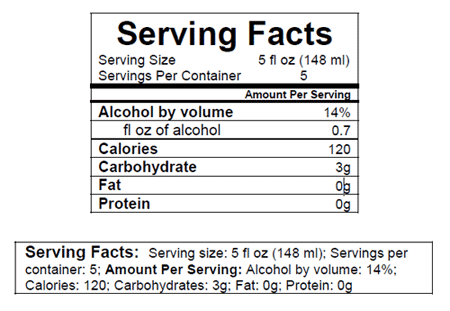For the better part of a decade, the Alcohol and Tobacco Tax and Trade Bureau (TTB) has been nursing the idea of mandatory calorie and nutrient labeling of alcoholic beverages. The bottom of that particular glass is still nowhere in sight; the Bureau continues to pore over submissions from a comment period that closed in January 2008. Several months ago, however, as an interim measure, the TTB authorized an expanded version of the nutrient content statement that has been allowable since 2004.
TTB Ruling 2013-2, issued on May 28, 2013, modified a 2004 TTB ruling that permits – and, in the case of such representations as “low carb,” requires – the inclusion on alcoholic beverages of a “statement of average analysis.” The new ruling goes further by authorizing the voluntary use of a “Serving Facts statement” on labels and in advertisements. Serving Facts include a drink’s serving size, the number of servings per container, and the calories and grams of carbohydrates, protein and fat per serving. Such a listing differs from a statement of average analysis only by the addition of a title, serving size, the number of servings per container and an optional declaration of alcohol content.
Ruling 2013-2 also makes the TTB’s serving sizes more nuanced, in part by taking into account alcohol content and the ways in which various drinks are typically consumed. Its most novel aspect, however, may be its allowance in the Serving Facts statement of the number of U.S. fluid ounces of pure ethyl alcohol per serving – so long as such a statement is accompanied by the more traditional percent-by-volume declaration. The change reflects the fact that many public health agencies provide consumption advice based on fluid ounces.
Ruling 2013-2 specifies a format for the new Serving Facts statements, which can be linear or tabular but must conform to one of six samples. New certificates of label approval are not necessary for labels that are revised solely to include a statement of average analysis (in accordance with Ruling 2004-1) or a Serving Facts statement (in accordance with Ruling 2013-2), even if the newly added information is on a distinct neck or strip label.

Examples of tabular and linear labels.
The TTB issued Ruling 2013-2 in response to inquiries from industry members interested in disclosing additional information and in the midst of a discussion initiated by a 2003 petition from consumer interest groups. That petition advocated, among other things, an “Alcohol Facts” statement that would include standardized serving sizes and a uniform definition of “moderate drinking.” Proponents of additional disclosures argue that the growing diversity of alcoholic beverages has left consumers guessing at caloric and alcohol content.
Ruling 2013-2 does not obligate producers who choose to use Serving Facts statements to include alcohol content on those statements. They must, however, still comply with existing regulations regarding the disclosure of alcohol content on labels. Moreover, and as the TTB made explicit in 2013-2, the bottom line continues to be truthfulness and accuracy. Disclosures that risk misleading the consumer will prompt action, whether from the Bureau or from private litigants.
The ruling and labeling details can be found at https://www.ttb.gov/images/pdfs/rulings/2013-2.pdf.